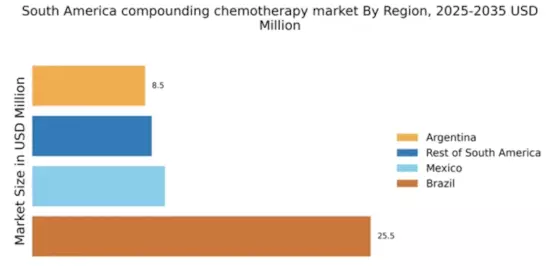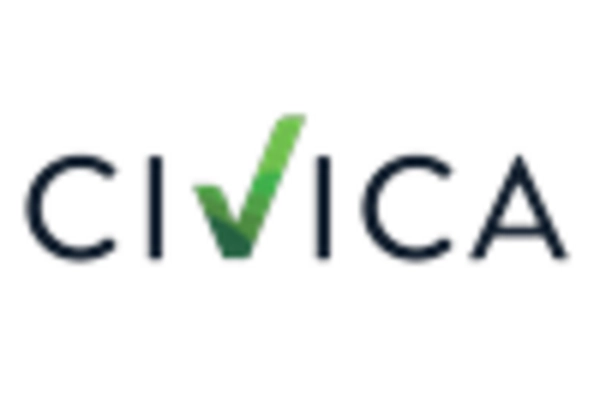Increasing Cancer Incidence
The rising incidence of cancer in South America is a critical driver for the compounding chemotherapy market. According to recent statistics, cancer cases in the region have escalated, with projections indicating a growth rate of approximately 3.5% annually. This surge necessitates tailored treatment options, as traditional therapies may not suffice for all patients. The compounding chemotherapy market is poised to benefit from this trend, as healthcare providers seek customized solutions to address the unique needs of patients. Furthermore, the increasing awareness of cancer screening and early detection is likely to contribute to higher treatment rates, thereby expanding the market for compounded chemotherapy solutions.
Rising Healthcare Expenditure
The increase in healthcare expenditure across South America is a pivotal driver for the compounding chemotherapy market. Governments and private sectors are investing more in healthcare infrastructure, which includes the development of compounding pharmacies. This investment is expected to rise by approximately 7% annually, reflecting a commitment to improving access to essential medications, including compounded chemotherapy. As healthcare systems expand, the availability of compounded treatments is likely to increase, meeting the growing demand from oncologists and patients alike. This trend not only supports the market's growth but also enhances the overall quality of cancer care in the region.
Growing Patient-Centric Care Models
The shift towards patient-centric care models in South America is reshaping the compounding chemotherapy market. Healthcare providers are increasingly focusing on individualized treatment plans that cater to the specific needs of patients. This approach is particularly relevant in oncology, where the effectiveness of chemotherapy can vary significantly among individuals. As a result, the demand for compounded chemotherapy solutions that are tailored to patient profiles is on the rise. Market analysts suggest that this trend could lead to a growth rate of around 6% in the coming years, as more healthcare facilities adopt personalized treatment strategies to enhance patient satisfaction and outcomes.
Advancements in Pharmaceutical Compounding
Technological innovations in pharmaceutical compounding are significantly influencing the compounding chemotherapy market in South America. The introduction of sophisticated compounding equipment and software has enhanced the precision and safety of drug preparation. For instance, automated compounding systems can reduce human error and ensure consistent dosages, which is crucial for chemotherapy agents. As a result, healthcare facilities are increasingly adopting these technologies, leading to a projected market growth of around 4% annually. This trend not only improves patient outcomes but also fosters a more efficient workflow within pharmacies, thereby driving the demand for compounded chemotherapy solutions.
Regulatory Support for Compounded Medications
Regulatory frameworks in South America are evolving to support the compounding chemotherapy market. Recent initiatives by health authorities aim to streamline the approval processes for compounded medications, ensuring that patients have timely access to necessary treatments. This regulatory support is crucial, especially in regions where access to commercially available chemotherapy drugs may be limited. The market is expected to grow by approximately 5% as a result of these favorable regulations, which encourage pharmacies to expand their compounding services. Enhanced compliance with safety standards also reassures healthcare providers and patients, further driving the adoption of compounded chemotherapy.


















Leave a Comment